Synthesis of AZO-Coated ZnO Core–Shell Nanorods by Mist Chemical Vapor Deposition for Wastewater Treatment Applications
Abstract
1. Introduction
2. Results and Discussion
3. Experiments
3.1. Deposition of AZO Film by Radio Frequency Magnetron Sputtering
3.2. Synthesis of ZnO Nanorods by CBD
3.3. Fabrication of AZO/ZnO Core–Shell Nanorods by Mist CVD
3.4. Photodegradation Measurement
3.5. Characterizations
4. Conclusions
Author Contributions
Funding
Institutional Review Board Statement
Informed Consent Statement
Data Availability Statement
Conflicts of Interest
References
- Ballantyne, A.; Alden, C.; Miller, J.; Tans, P.P.; White, J.W.C. Increase in observed net carbon dioxide uptake by land and oceans during the last 50 years. Nature 2012, 488, 70–72. [Google Scholar] [CrossRef] [PubMed]
- Van Zelm, R.; Preiss, P.; Van Goethem, T.; Van Dingenen, R.; Huijbregts, M.A.J. Regionalized life cycle impact assessment of air pollution on the global scale: Damage to human health and vegetation. Atmos. Environ. 2016, 134, 129–137. [Google Scholar] [CrossRef]
- Caetano, N.S.; Mata, T.M.; Martins, A.A.; Felgueiras, M.C. New Trends in Energy Production and Utilization. Energy Procedia 2017, 107, 7–14. [Google Scholar] [CrossRef]
- Pakshirajan, K.; Singh, S. Decolorization of synthetic wastewater containing azo dyes in a batch-operated rotating biological contactor reactor with the immobilized fungus phanerochaete chrysosporium. Ind. Eng. Chem. Res. 2010, 49, 7484–7487. [Google Scholar] [CrossRef]
- Nehra, K.; Anju, M.; Malik, K. Isolation and optimization of conditions for maximum decolorization by textile-dye decolorizing bacteria. Pollut. Res. 2008, 27, 257–264. [Google Scholar]
- Singha, K.; Pandit, P.; Maity, S.; Sharma, S.R. Harmful Environmental Effects for Textile Chemical Dyeing Practice. In Green Chemistry for Sustainable Textiles; Woodhead Publishing: Cambridge, UK, 2021; pp. 153–164. [Google Scholar]
- Sala, M.; Gutiérrez-Bouzán, M.C. Electrochemical Techniques in Textile Processes and Wastewater Treatment. Int. J. Photoenergy 2012, 2012, 629103. [Google Scholar] [CrossRef]
- Sudha, M.; Saranya, A.; Selvakumar, G.; Sivakumar, N. Microbial degradation of azo dyes: A review. Int. J. Curr. Microbiol. Appl. Sci. 2014, 3, 670–690. [Google Scholar]
- Patil, N.P.; Bholay, A.D.; Kapadnis, B.P.; Gaikwad, V.B. Biodegradation of model azo dye methyl red and other textile dyes by isolate bacillus circulans npp1. J. Pure Appl. Microbiol. 2016, 10, 2793–2800. [Google Scholar] [CrossRef]
- Maniyam, M.N.; Ibrahim, A.L.; Cass, A.E.G. Decolourization and biodegradation of azo dye methyl red by Rhodococcus strain UCC 0016. Environ. Technol. 2020, 41, 71–85. [Google Scholar] [CrossRef]
- Abdelaal, S.A.A.; Moustafa, M.S.S.; Ahmed, K.; Ahmed, N.R.M.N.; Mohamed, H.A. Removal of methyl red from wastewater using a NiO@Hyphaene thebaica seed-derived porous carbon adsorbent: Kinetics and isotherm studies. R. Soc. Chem. 2023, 4, 2981–2990. [Google Scholar]
- Ruan, W.; Hu, J.; Qi, J.; Hou, Y.; Zhou, C.; Wei, X. Removal of dyes from wastewater by nanomaterials: A review. Adv. Mater. Lett. 2019, 10, 9–20. [Google Scholar] [CrossRef]
- Dawadi, K.B.; Bhattarai, M.; Homagai, P.L. Adsorptive removal of methyl red from aqueous solution using charred and xanthated sal (Shorea robusta) sawdust. Amrit Res. J. 2020, 1, 37–44. [Google Scholar] [CrossRef]
- Jamjoum, H.A.A.; Umar, K.; Adnan, R.; Razali, M.R.; Ibrahim, M.N.M. Synthesis, Characterization, and Photocatalytic Activities of Graphene Oxide/metal Oxides Nanocomposites: A Review. Front. Chem. 2021, 9, 752276. [Google Scholar] [CrossRef] [PubMed]
- Védrine, J.C. Metal Oxides in Heterogeneous Oxidation Catalysis: State of the Art and Challenges for a More Sustainable World. ChemSusChem 2019, 12, 577–588. [Google Scholar] [CrossRef] [PubMed]
- Abo-Dief, H.M.; Hussein, O.K.; Ihsan, A.; El-Bahy, S.M.; Raslan, A.M.; Shahid, M.; Warsi, M.F. Ternary metal oxide WO3.NiO. ZnO nanoparticles and their composite with CNTs for organic dye photocatalytic degradation. Ceram. Int. 2022, 48, 22228–22236. [Google Scholar] [CrossRef]
- Gautam, S.; Agrawal, H.; Thakur, M.; Akbari, A.; Sharda, H.; Kaur, R.; Amini, M. Metal Oxides and Metal Organic Frameworks for the Photocatalytic Degradation: A Review. J. Environ. Chem. Eng. 2020, 8, 103726. [Google Scholar] [CrossRef]
- Luevano-Hipolito, E.; Martinez-de la Cruz, A.; Cuellar, E.L. Performance of ZnO synthesized by sol-gel as photocatalyst in the photooxidation reaction of NO. Environ. Sci. Pollut. Res. 2016, 24, 6361–6371. [Google Scholar] [CrossRef] [PubMed]
- Xie, J.; Wang, H.; Duan, M.; Zhang, L. Synthesis and photocatalysis properties of ZnO structures with different morphologies via hydrothermal method. Appl. Surf. Sci. 2011, 257, 6358–6363. [Google Scholar] [CrossRef]
- Samadi, M.; Zirak, M.; Naseri, A.; Khorashadizade, E.; Moshfegh, A.Z. Recent progress on doped ZnO nanostructures for visible-light photocatalysis. Thin Solid Film. 2016, 605, 2–19. [Google Scholar] [CrossRef]
- Ebrahimi, H.R.; Modrek, M. Photocatalytic Decomposition of Methyl Red Dye by Using Nanosized Zinc Oxide Deposited on Glass Beads in Various pH and Various Atmosphere. J. Chem. 2013, 2012, 151034. [Google Scholar] [CrossRef]
- Yang, X.; Tian, J.; Guo, Y.; Teng, M.; Liu, H.; Li, T.; Lv, P.; Wang, X. ZnO Nano-Rod Arrays Synthesized with Exposed {0001} Facets and the Investigation of Photocatalytic Activity. Crystals 2021, 11, 522. [Google Scholar] [CrossRef]
- Wai, H.S.; Li, C. Fabrication of Well-aligned ZnO Nanorods with Different Reaction Times by Chemical Bath Deposition Method Applying for Photocatalysis Application. Molecules 2023, 28, 397–409. [Google Scholar] [CrossRef] [PubMed]
- Shan, F.K.; Yu, Y.S. Bandgap energy of pure and Al-doped ZnO thin films. J. Eur. Ceram. Soc. 2004, 24, 1869–1872. [Google Scholar] [CrossRef]
- Wai, H.S.; Li, C. Effect of Aluminum Doping Ratios on the Properties of Aluminum-doped Zinc Oxide Films Deposited by Mist Chemical Vapor Deposition Method Applying for Photocatalysis. Nanomaterials 2022, 12, 195–206. [Google Scholar] [CrossRef] [PubMed]
- De Queiroz, J.C.A.; Filho, J.B.D.A.; Feitor, M.C.; Liborio, M.S.; Santos, E.J.D.C.; Souto, U.B.; Dousa, R.R.M.D.; Coasta, T.H.D.C. Structural and Optical Properties of ZnO: Al Thin Films Produced by Magnetron Sputtering with Different Oxygen Flow: An Experimental and Ab Initio Study. Phys. Status Solidi A 2020, 217, 202000167. [Google Scholar] [CrossRef]
- Patterson, A.L. The Scherrer Formula for X-ray Particle Size Determination. Phys. Rev. 1939, 56, 978–982. [Google Scholar] [CrossRef]
- Fewster, P.F. X-ray analysis of thin films and multilayers. Rep. Prog. Phys. 1996, 59, 1339–1342. [Google Scholar] [CrossRef]
- Kawaharamura, T.; Uchida, T.; Sanada, M.; Furuta, M. Growth and electrical properties of AlOx grown by mist chemical vapor deposition. AIP Adv. 2013, 3, 032135–032145. [Google Scholar] [CrossRef]
- Tauc, J. Optical properties and electronic structure of amorphous Ge and Si. Mater. Res. Bull. 1968, 3, 37–46. [Google Scholar] [CrossRef]
- Devi, L.G.; Raju, K.S.A.; Kumar, S.G. Photodegradation of methyl red by advanced and homogeneous photo-Fenton’s processes: A comparative study and kinetic approach. J. Environ. Monit. 2009, 11, 1397–1404. [Google Scholar] [CrossRef]
- Seong, S.; Park, I.; Jung, Y.C.; Lee, T.; Kim, S.Y.; Park, J.S.; Ko, J.H.; Ahn, J. Synthesis of Ag-ZnO core-shell nanoparticles with enhanced photocatalytic activity through atomic layer deposition. Mater Des. 2019, 177, 107831. [Google Scholar] [CrossRef]
- Mondal, K.; Sharma, A. Recent advances in the synthesis and application of photocatalytic metal-metal oxide core-shell nanoparticles for environmental remediation and their recycling process. RSC Adv. 2016, 6, 83589–83612. [Google Scholar] [CrossRef]
- Al-Rasheedi, A.; Salwati, A.; Ansari, A.R.; Hassaneen, A.A.D. Photocatalysis activity of ZnO nanorods arrays prepared via hydrothermal. Inorg. Chem. Commun. 2023, 158, 111568. [Google Scholar] [CrossRef]
- Loghambal, S.; Catherine, A.J.A.; Subash, S.V. Analysis of langmuir-hinshelwood kinetics model for photocatalytic degradation of aqueous direct blue 71 through analytical expression. Int. J. Math. Appl. 2018, 6, 903–913. [Google Scholar]
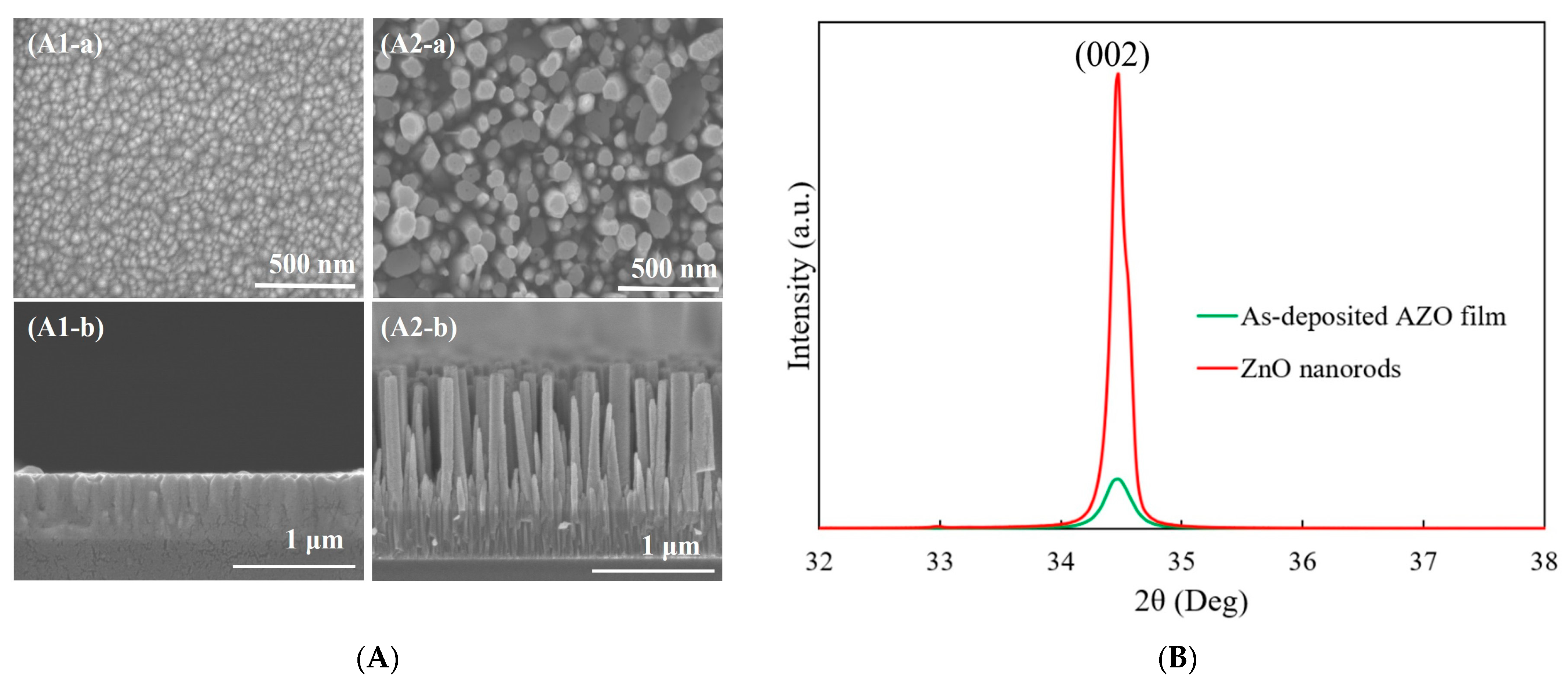

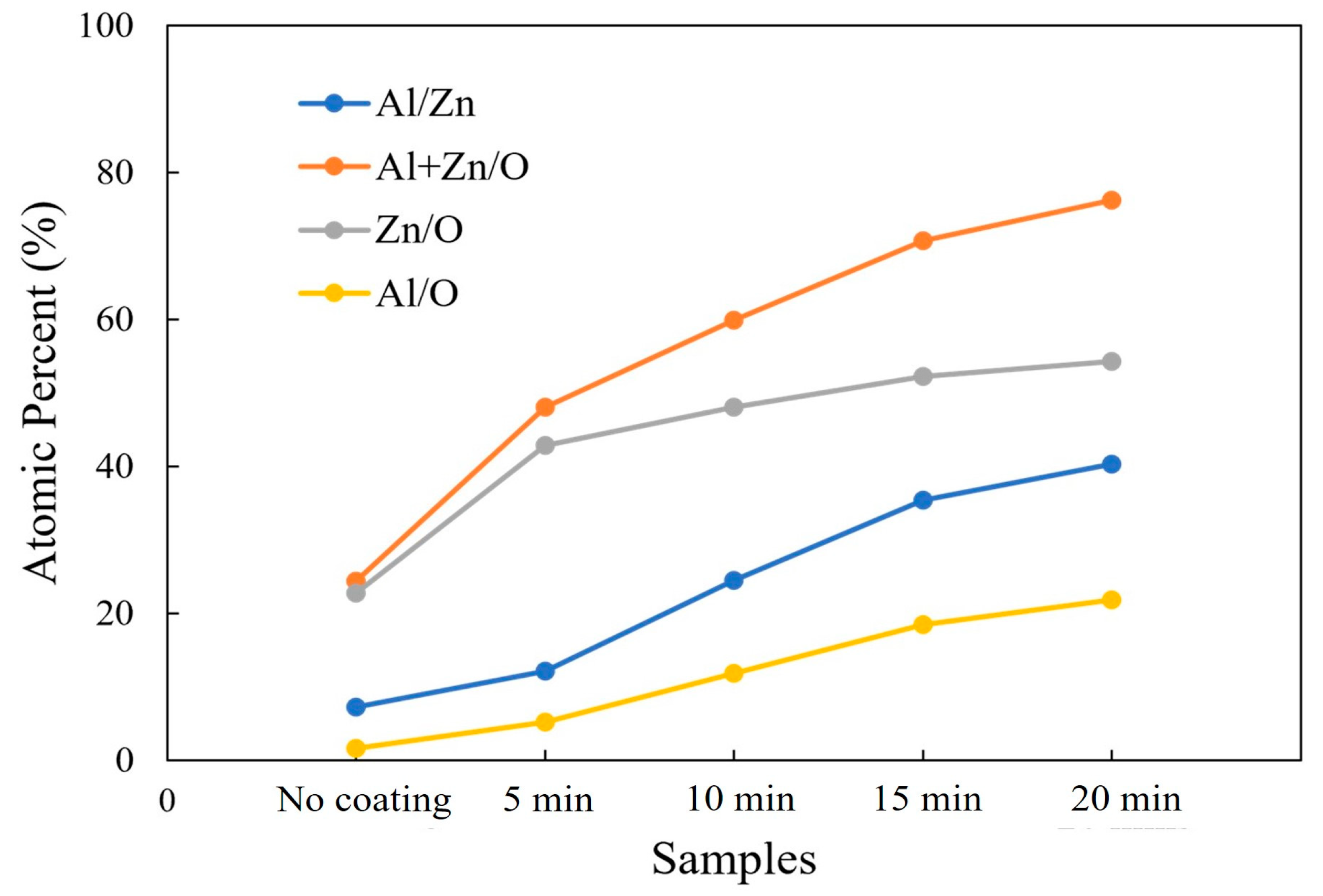

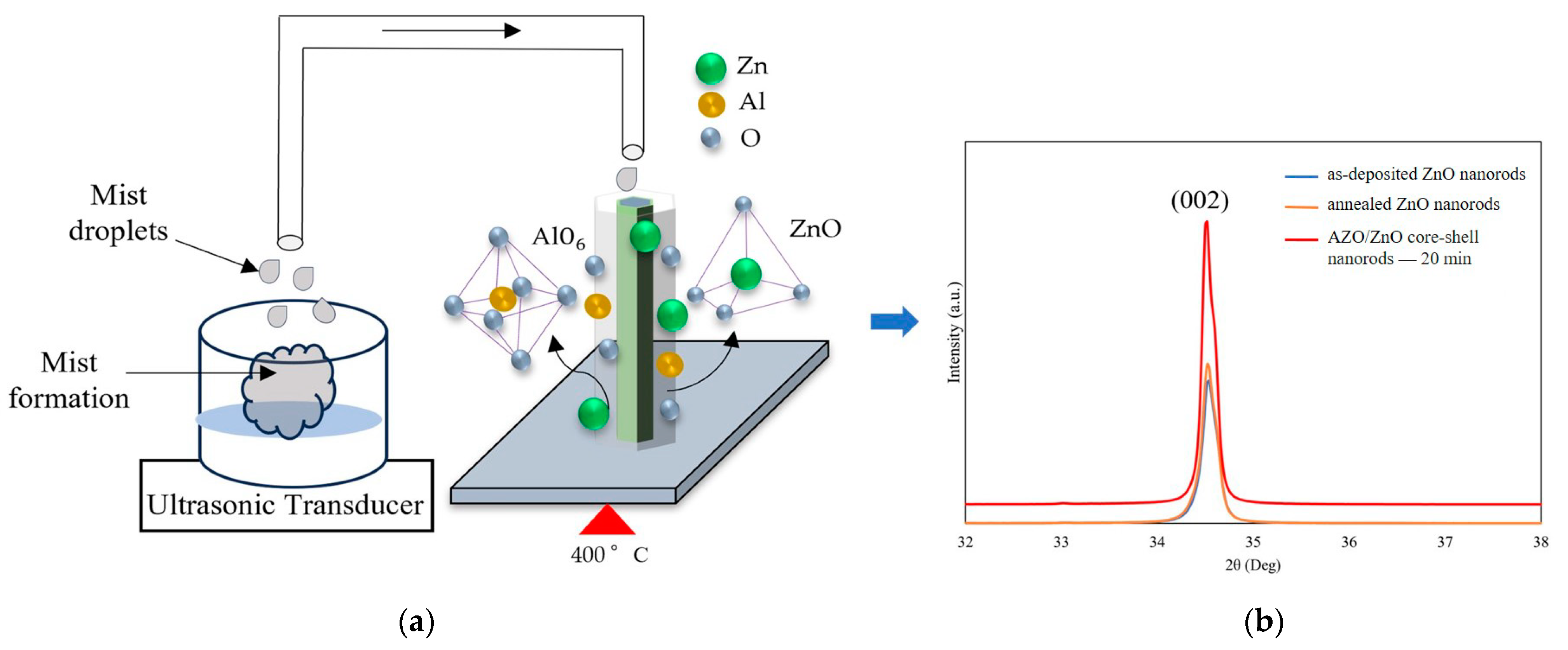
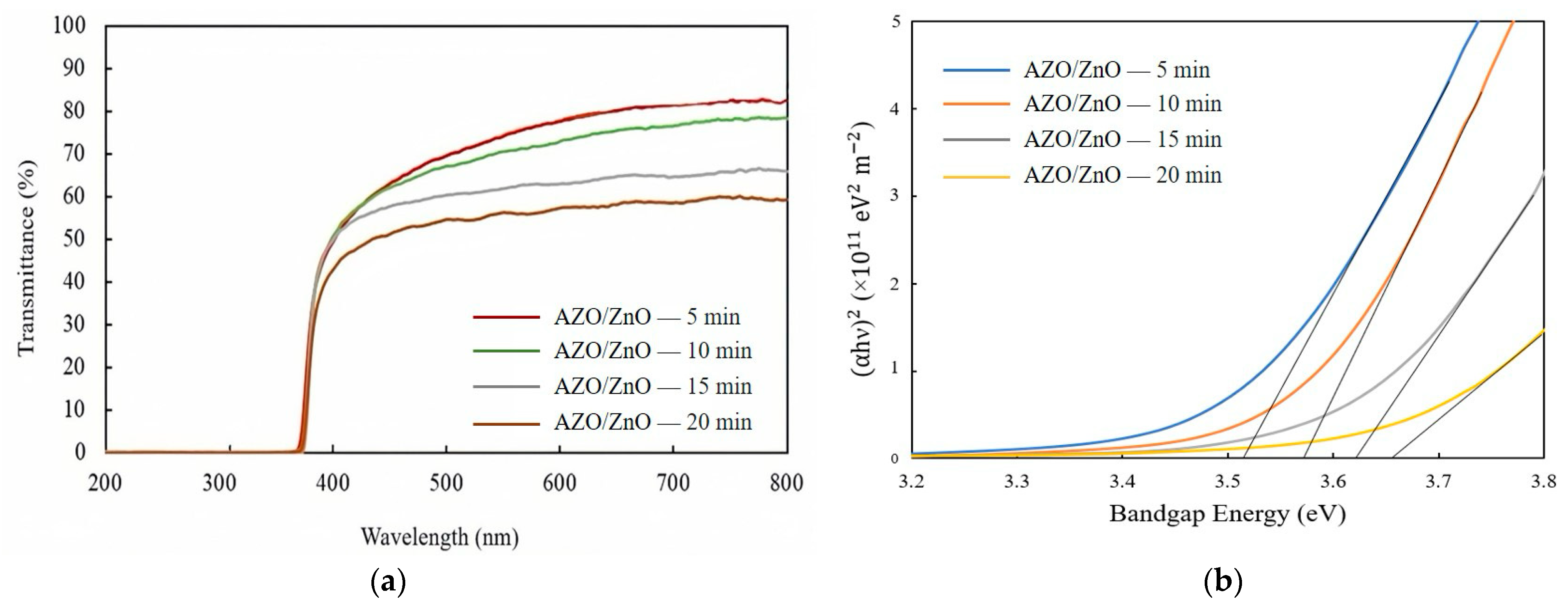
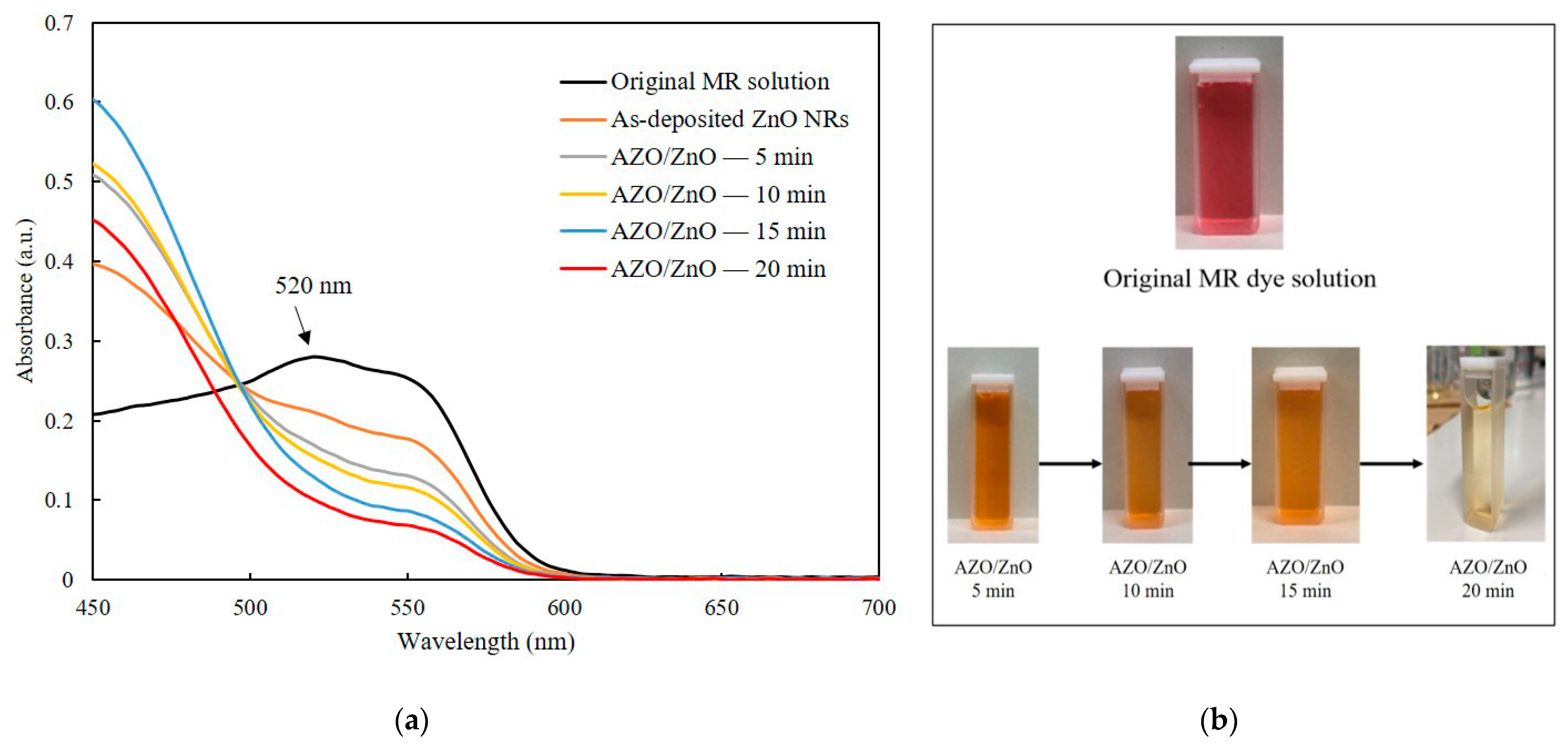
| Sample | Degradation Rate, k (min−1) |
|---|---|
| AZO/ZnO—5 min | 0.0039 |
| AZO/ZnO—10 min | 0.0042 |
| AZO/ZnO—15 min | 0.0043 |
| AZO/ZnO—20 min | 0.0053 |
| Deposition Parameter | Condition |
|---|---|
| Target | AZO (ZnO:Al2O3 = 98:2 wt%) |
| Substrate | Glass |
| Temperature (°C) | 150 |
| Power (W) | 100 |
| Pressure (Pa) | 1 |
| Working gas, Ar (sccm) | 30 |
| Deposition Parameters | Conditions |
|---|---|
| Solute | Zinc acetate, aluminum acetylacetonate |
| Solvent | Methanol, water |
| Concentration (mol) | 0.04 |
| Doping concentration (%) | 2 |
| Substrate | ZnO nanorods/AZO thin film |
| Temperature (°C) | 400 |
| Carrier gas, Flow rate (L/min) | N2, 2.5 |
| Dilution gas, Flow rate (L/min) | N2, 4.5 |
| AZO coating time (min) | 5, 10, 15, 20 |
Disclaimer/Publisher’s Note: The statements, opinions and data contained in all publications are solely those of the individual author(s) and contributor(s) and not of MDPI and/or the editor(s). MDPI and/or the editor(s) disclaim responsibility for any injury to people or property resulting from any ideas, methods, instructions or products referred to in the content. |
© 2024 by the authors. Licensee MDPI, Basel, Switzerland. This article is an open access article distributed under the terms and conditions of the Creative Commons Attribution (CC BY) license (https://creativecommons.org/licenses/by/4.0/).
Share and Cite
Wai, H.S.; Ikuta, T.; Li, C. Synthesis of AZO-Coated ZnO Core–Shell Nanorods by Mist Chemical Vapor Deposition for Wastewater Treatment Applications. Molecules 2024, 29, 309. https://doi.org/10.3390/molecules29020309
Wai HS, Ikuta T, Li C. Synthesis of AZO-Coated ZnO Core–Shell Nanorods by Mist Chemical Vapor Deposition for Wastewater Treatment Applications. Molecules. 2024; 29(2):309. https://doi.org/10.3390/molecules29020309
Chicago/Turabian StyleWai, Htet Su, Tomoya Ikuta, and Chaoyang Li. 2024. "Synthesis of AZO-Coated ZnO Core–Shell Nanorods by Mist Chemical Vapor Deposition for Wastewater Treatment Applications" Molecules 29, no. 2: 309. https://doi.org/10.3390/molecules29020309
APA StyleWai, H. S., Ikuta, T., & Li, C. (2024). Synthesis of AZO-Coated ZnO Core–Shell Nanorods by Mist Chemical Vapor Deposition for Wastewater Treatment Applications. Molecules, 29(2), 309. https://doi.org/10.3390/molecules29020309





